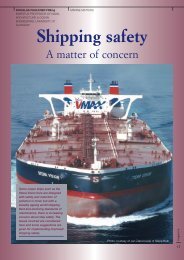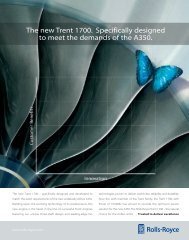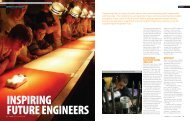Chris Mitchell is a man with vision â and a fleet of dinghies ... - Ingenia
Chris Mitchell is a man with vision â and a fleet of dinghies ... - Ingenia
Chris Mitchell is a man with vision â and a fleet of dinghies ... - Ingenia
Create successful ePaper yourself
Turn your PDF publications into a flip-book with our unique Google optimized e-Paper software.
INNOVATION<br />
The first Access Dinghy prototype on its maiden sail at S<strong>and</strong>ringham, seen sailing downwind under asymmetric spinnaker © Access Dinghy<br />
UNIVERSAL<br />
DINGHIES<br />
<strong>Chr<strong>is</strong></strong> <strong>Mitchell</strong> <strong>is</strong> a <strong>man</strong> <strong>with</strong> v<strong>is</strong>ion – <strong>and</strong> a <strong>fleet</strong> <strong>of</strong> <strong>dinghies</strong> to prove it. He has helped<br />
hundreds <strong>of</strong> d<strong>is</strong>abled people d<strong>is</strong>cover the freedom <strong>of</strong> sailing, through h<strong>is</strong> Access Dinghy<br />
Foundation. Sally Wilkes found out more about h<strong>is</strong> new prize-winning skiff that will<br />
power sailors all the way to the 2008 Paralympics in Beijing.<br />
ISSUE 27 JUNE 2006<br />
31
INNOVATION<br />
Bethwaite, th<strong>is</strong> type <strong>of</strong> boat<br />
design does not subscribe to<br />
neat equations. He fine-tuned<br />
the hull by towing the SKUD18<br />
hull behind a speedboat <strong>and</strong><br />
plotting drag curves, ensuring<br />
the design parameters such as<br />
keel weight, draft (keel depth in<br />
the water) <strong>and</strong> uncrewed mass<br />
d<strong>is</strong>placement were maintained.<br />
The final design has low drag,<br />
meaning the boat heels fairly<br />
easily but gives a faster ride.<br />
carbon fibre bowsprit, completes<br />
the sail tally, taking the boat<br />
above a speedy twelve knots.<br />
An asymmetric, rather than<br />
st<strong>and</strong>ard, spinnaker <strong>is</strong> particularly<br />
effective on fast planing skiffs<br />
like the SKUD18 because they<br />
are fast enough to generate an<br />
increase in apparent wind when<br />
reaching (sailing across the<br />
wind), so it <strong>is</strong> <strong>of</strong>ten faster to zig<br />
zag to the bottom mark rather<br />
than sailing directly downwind.<br />
The SKUD18 <strong>with</strong> its double rudder <strong>and</strong> bulb keel configuration on clear d<strong>is</strong>play © Access Dinghy<br />
The SKUD18 (SKiff Universal<br />
Design) was selected on<br />
7 November 2005, by the<br />
International Association <strong>of</strong><br />
D<strong>is</strong>abled Sailing (IFDS), as the<br />
Paralympic vessel <strong>of</strong> choice in<br />
the two-person keelboat<br />
event. It then quickly snapped<br />
up its first accolade: the<br />
Australian Sports Innovation<br />
Award in February th<strong>is</strong> year.<br />
The vessel <strong>is</strong> the latest <strong>and</strong><br />
snappiest in the stable <strong>of</strong> Access<br />
Dinghy sailboats but, as <strong>Mitchell</strong><br />
points out, it <strong>is</strong> not a d<strong>is</strong>abled<br />
sailing boat per se. Rather, he <strong>is</strong><br />
creating a universal craft that can<br />
be adapted for virtually anyone<br />
to sail, regardless <strong>of</strong> skill or<br />
physical prowess. “We take the<br />
most difficult <strong>and</strong> complicated<br />
cases <strong>and</strong> get them sailing, <strong>and</strong><br />
the others just fall along in line.”<br />
SKIFFS FOR ALL<br />
Admittedly the SKUD18 will take<br />
a little more taming than the<br />
Liberty; the Access Dinghy club<br />
boat design that the SKUD took<br />
inspiration from. At 5.8m long,<br />
th<strong>is</strong> lead-ass<strong>is</strong>ted skiff (a type <strong>of</strong><br />
dinghy) has an asymmetrical<br />
spinnaker <strong>and</strong> hi-tech rig making<br />
it the ‘turbo’ class special<strong>is</strong>ed<br />
version designed for top-level<br />
perfor<strong>man</strong>ce <strong>and</strong> excitement –<br />
<strong>with</strong> a cr<strong>is</strong>p response that <strong>is</strong><br />
equally challenging for both<br />
able-bodied <strong>and</strong> d<strong>is</strong>abled sailors.<br />
But while the skiff <strong>is</strong> high on<br />
thrills, spills must be contained –<br />
the Paralympic competition will<br />
be a strict one-design class to<br />
create equity for all competitors,<br />
<strong>with</strong> two sailors seated (<strong>and</strong> in<br />
most cases, strapped in) on the<br />
centreline. The addition <strong>of</strong> a<br />
spinnaker sail means the boat<br />
could get knocked down, so selfrighting<br />
<strong>and</strong> self-draining<br />
features are vital. The SKUD18<br />
had to be designed for the<br />
worst-case tip scenario – a<br />
ventilated tetraplegic who<br />
can only move their tongue –<br />
making it imperative that all<br />
seats are clear <strong>of</strong> the water when<br />
the boat <strong>is</strong> on its side. Other<br />
design configurations allow at<br />
least one person to move<br />
around the boat, so edge seats<br />
also need to be kept out <strong>of</strong> the<br />
water during heeling (where the<br />
boat leans over). Th<strong>is</strong><br />
combination <strong>of</strong> spinnaker <strong>and</strong><br />
central seating <strong>is</strong> an innovation<br />
in th<strong>is</strong> class.<br />
CONCEPT AND DESIGN<br />
The SKUD18 concept came to<br />
life two years ago <strong>and</strong> has<br />
involved collaboration <strong>with</strong><br />
renowned Australian skiff<br />
designer Julian Bethwaite (who<br />
designed the Olympic class 49er<br />
skiff ), <strong>and</strong> naval architect Martin<br />
Billoch to bring it to th<strong>is</strong> stage.<br />
From the beginning <strong>Mitchell</strong><br />
knew he was going for a faster<br />
planing hull, rather than the<br />
more stable d<strong>is</strong>placement hull<br />
<strong>of</strong> h<strong>is</strong> earlier models.<br />
The final hull design <strong>is</strong> an<br />
8mm PVC foam s<strong>and</strong>wich <strong>with</strong><br />
bi-directional glass <strong>and</strong> polyester<br />
resin; a cheap <strong>and</strong> lightweight<br />
combination. The boat’s<br />
buoyancy chamber contains<br />
500 litres <strong>of</strong> foam, forcing the<br />
skiff to remain upright <strong>with</strong> more<br />
than 100mm freeboard (the<br />
height <strong>of</strong> the boat that <strong>is</strong> above<br />
the water) when sailing <strong>with</strong><br />
the buoyancy chamber totally<br />
flooded <strong>and</strong> the cockpit filled.<br />
SKIFF STABILITY<br />
A wildly heeling dinghy<br />
needs a serious underwater<br />
counterweight, <strong>and</strong> th<strong>is</strong> <strong>is</strong><br />
provided by a bulb keel <strong>with</strong><br />
150kg <strong>of</strong> lead working as a<br />
righting device. Two oversized<br />
rudders also mean control <strong>is</strong><br />
maintained during heeling,<br />
allowing the boat to heel to<br />
45 degrees comfortably.<br />
Directional stability <strong>is</strong> also<br />
maintained by a large jib sail,<br />
which loads the bow up in<br />
powerful winds, keeping the<br />
boat on course <strong>and</strong> balancing<br />
the helm. <strong>Mitchell</strong> admits th<strong>is</strong><br />
feature was d<strong>is</strong>covered by<br />
serendipity when trialling the<br />
Liberty, <strong>and</strong> was subsequently<br />
incorporated into the SKUD18.<br />
According to <strong>Mitchell</strong>,<br />
experiencing a wild heel <strong>is</strong><br />
rather unnerving at first for a<br />
strapped-in sailor, but the<br />
helms<strong>man</strong> has good v<strong>is</strong>ibility,<br />
since the stern r<strong>is</strong>es in the air as<br />
the boat heels, <strong>and</strong> transparent<br />
Mylar sails give a good all-round<br />
view. The high boom removes<br />
the threat <strong>of</strong> being hit on the<br />
head – the scourge <strong>of</strong> small<br />
dinghy sailing when going about!<br />
Testing <strong>of</strong> the hull stability <strong>and</strong><br />
perfor<strong>man</strong>ce enhancement was<br />
achieved through a mixture <strong>of</strong><br />
experience, engineering, <strong>and</strong> trial<br />
<strong>and</strong> error, scaling down the<br />
ratios <strong>and</strong> lines <strong>of</strong> Bethwaite’s<br />
79er skiff. According to<br />
THE RIG<br />
In technical terms, the boat has a<br />
sloop rig (th<strong>is</strong> refers to the sail<br />
arrangement, including the mast,<br />
sails <strong>and</strong> ropes) <strong>with</strong> high roach,<br />
which, loosely, <strong>is</strong> the mainsail<br />
radius <strong>and</strong> an indicator <strong>of</strong> the<br />
boat’s speed capability. The rig’s<br />
auto de-powering function <strong>is</strong> a<br />
safety measure <strong>of</strong>ten used in<br />
boats <strong>of</strong> th<strong>is</strong> class. By encouraging<br />
the top <strong>of</strong> the mast to flex, air <strong>is</strong><br />
allowed to spill out <strong>of</strong> the sails at<br />
very high speeds in an attempt<br />
to avoid excessive heeling. The<br />
mainsail <strong>is</strong> fully battened<br />
(battens extend horizontally<br />
across the mainsail) for optimum<br />
perfor<strong>man</strong>ce <strong>and</strong> a self-tacking<br />
jib eases h<strong>and</strong>ling. The ‘boost<br />
function’, a tube-launched<br />
asymmetric spinnaker on a<br />
ENABLING CONTROLS<br />
To put the challenge <strong>of</strong><br />
designing for th<strong>is</strong> de<strong>man</strong>ding<br />
group <strong>of</strong> sailors into perspective,<br />
<strong>Mitchell</strong> classes someone<br />
<strong>with</strong> cerebral palsy as: “among<br />
the hardest to get sailing<br />
competitively… because they<br />
have spasms in their h<strong>and</strong>s <strong>and</strong><br />
limbs, <strong>and</strong> can have difficulty<br />
getting their h<strong>and</strong>s <strong>and</strong> fingers<br />
to follow instructions from the<br />
brain. They may also have<br />
communication problems on<br />
crewed boats as speech can<br />
be impaired.”<br />
<strong>Mitchell</strong>’s team has a vast<br />
tool kit <strong>of</strong> innovative electronic<br />
servo-ass<strong>is</strong>t controls <strong>and</strong><br />
winches at its d<strong>is</strong>posal, to help<br />
d<strong>is</strong>abled sailors make use <strong>of</strong> their<br />
strongest or most useful body<br />
part to control the boat.<br />
A st<strong>and</strong>ard joystick controller. Access Dinghy make these controllers for fore <strong>and</strong> aft<br />
mounting on the arm rests – left or right h<strong>and</strong>ed – <strong>with</strong> a variety <strong>of</strong> options using<br />
any combination <strong>of</strong> toggle switches, push buttons, reed switches etc © Access Dinghy<br />
“Another person we got sailing could only<br />
move their tongue against their cheek, so we<br />
fixed a strip <strong>with</strong> pressure switches across the<br />
face to give three points <strong>of</strong> activation at each<br />
station. They could control the lot <strong>with</strong> that.”<br />
A two-straw sip <strong>and</strong> puff Liberty controller <strong>with</strong> a magnetic reed switch which<br />
d<strong>is</strong>engages <strong>and</strong> engages the jib sheet winch. The controller <strong>is</strong> mounted centrally<br />
on a bridge. In the background are thoracic supports bolted to the backrest<br />
© Access Dinghy<br />
32<br />
INGENIA<br />
ISSUE 27 JUNE 2006 13 33
UNIVERSAL DINGHIES<br />
INNOVATION<br />
Generally, the most physically<br />
d<strong>is</strong>abled sailor would take the<br />
helm at the rear <strong>of</strong> the boat <strong>and</strong><br />
use a <strong>man</strong>ual or servo-ass<strong>is</strong>ted<br />
joystick to drive the rudders,<br />
while the second person –<br />
someone <strong>with</strong> arm strength –<br />
would control the sails. It would<br />
be possible to have a severely<br />
d<strong>is</strong>abled crew controlling the<br />
whole boat using rope h<strong>and</strong>line<br />
functions, or for just one person<br />
to use a four-way joystick for<br />
steering <strong>and</strong> pulling in the<br />
sheets. As both sailors sit on<br />
the centreline in the Paralympic<br />
setup, traditional boundaries<br />
between helm <strong>and</strong> crew are<br />
blurred <strong>and</strong> both sailors could<br />
operate any <strong>of</strong> the controls.<br />
Servo-ass<strong>is</strong>t controls <strong>and</strong><br />
winches can control the helm<br />
(<strong>with</strong> a variable speed option)<br />
<strong>and</strong> the rig. Manual controls<br />
include joystick or push/pull<br />
Amethyst (Ame) was born <strong>with</strong> Phocoamelia. Th<strong>is</strong> <strong>is</strong> a condition that <strong>man</strong>ifests itself<br />
by the absence <strong>of</strong> limbs. Ame <strong>is</strong> sitting in a custom made seat fitted into her Access<br />
2.3 single seater dinghy. She has one short foot <strong>with</strong> three toes <strong>with</strong> which she<br />
controls the boat © Access Dinghy<br />
lines, a cleat console for easy sail<br />
control, <strong>and</strong> a single speed<br />
sheet-type winch for easy<br />
h<strong>and</strong>ling <strong>of</strong> other rig functions<br />
<strong>and</strong> the keel. The servo<br />
controller range includes a<br />
variety <strong>of</strong> electronic joysticks <strong>and</strong><br />
secondary control switches. Sip<br />
<strong>and</strong> puff controllers could be<br />
incorporated, but in practice<br />
they are not widely used.<br />
The servo winches on all<br />
Access Dinghy sailboats are<br />
powered by worm drive<br />
per<strong>man</strong>ent magnet DC motors,<br />
typically used for windscreen<br />
wipers but marin<strong>is</strong>ed to give a<br />
high IP53 corrosion res<strong>is</strong>tance<br />
rating. The winches use a glass<br />
bead coated friction drum <strong>and</strong><br />
can pull tension in both<br />
directions, so a single winch can<br />
trim both port <strong>and</strong> starboard<br />
sheets. Likew<strong>is</strong>e, a single winch<br />
can ra<strong>is</strong>e <strong>and</strong> lower the<br />
spinnaker by hauling on the<br />
halyard (rope) attached to the<br />
head <strong>of</strong> the sail.<br />
MULTI-FACETED<br />
<strong>Mitchell</strong> has spent years working<br />
<strong>with</strong> d<strong>is</strong>abled would-be sailors<br />
to come up <strong>with</strong> creative<br />
solutions for boat control. For<br />
example, a joystick can be<br />
operated <strong>with</strong> any body part,<br />
such as the h<strong>and</strong>, chin or<br />
tongue. The operating load<br />
would simply be reduced to<br />
accommodate the tongue.<br />
“Another person we got sailing<br />
could only move their tongue<br />
against their cheek, so we fixed<br />
a strip <strong>with</strong> pressure switches<br />
across the face to give three<br />
points <strong>of</strong> activation at each<br />
station. They could control the<br />
lot <strong>with</strong> that,” explains <strong>Mitchell</strong>.<br />
Another configuration uses a<br />
magnet attached to the cheek<br />
to operate reed switches.<br />
Access Dinghy are able to<br />
incorporate their own electronic<br />
systems into the SKUD18,<br />
including a 32 channel wireless<br />
transmitter that can operate<br />
16 winches. Th<strong>is</strong> means that, for<br />
extremely d<strong>is</strong>abled or novice<br />
sailors, a person <strong>with</strong> a controller<br />
can remain on shore <strong>and</strong><br />
effectively override the boat’s<br />
controls should a problem occur<br />
– rather like a remote-controlled<br />
model yacht. However, <strong>Mitchell</strong><br />
aims to keep the electronic side<br />
as simple as possible, in order<br />
to keep costs down <strong>and</strong> avoid<br />
malfunctioning.<br />
Those <strong>with</strong> sensory as well as<br />
physical d<strong>is</strong>abilities can also sail<br />
the SKUD18, though they would<br />
be more limited by the weather<br />
conditions. Blind sailors can<br />
orientate themselves using a<br />
talking compass that beeps<br />
according to the optimum angle<br />
to the wind, <strong>and</strong> can communicate<br />
<strong>with</strong> a shore-based guide via a<br />
radio link. An establ<strong>is</strong>hed system<br />
<strong>of</strong> insignias <strong>and</strong> verbal<br />
communication between<br />
competing boats also ex<strong>is</strong>ts in<br />
blind dinghy racing.<br />
FUNCTIONALITY<br />
AND FEEDBACK<br />
The boat’s functionality lies as<br />
much in what it cannot do as<br />
what it can, creating equity<br />
between sailors <strong>of</strong> different<br />
physical capabilities. For<br />
example, an able-bodied dinghy<br />
sailor normally uses a <strong>man</strong>ual<br />
rudder to alter the course <strong>of</strong> the<br />
boat, <strong>and</strong> makes constant (<strong>and</strong><br />
<strong>of</strong>ten subconscious) microadjustments<br />
to the tiller to<br />
account for changes in direction,<br />
swell <strong>and</strong> wind sensed through<br />
the tiller. The SKUD18 does not<br />
allow th<strong>is</strong>. “You can’t incorporate<br />
sensitivity <strong>of</strong> th<strong>is</strong> kind into a<br />
joystick or it would d<strong>is</strong>advantage<br />
someone like a tetraplegic who<br />
may have no feeling in their<br />
h<strong>and</strong>s, but has a small degree <strong>of</strong><br />
movement,” says <strong>Mitchell</strong>, who<br />
argues that it should be against<br />
class rules to allow steering that<br />
<strong>is</strong> too light.<br />
FULL SERVO FUTURE<br />
<strong>Mitchell</strong> <strong>is</strong> passionate about<br />
widening the acceptance <strong>of</strong> full<br />
servo sailing. “There’s nothing<br />
d<strong>is</strong>abled about using a joystick,”<br />
<strong>is</strong> an <strong>of</strong>t-heard <strong>man</strong>tra. Th<strong>is</strong><br />
may sound obvious given the<br />
joystick’s ubiquity among<br />
computer gamers, fighter jet<br />
pilots <strong>and</strong> motor boat pilots, but<br />
it <strong>is</strong> quite a leap <strong>of</strong> faith for<br />
experienced small boat sailors to<br />
h<strong>and</strong> over their <strong>man</strong>ual controls<br />
to servo controllers in what <strong>is</strong><br />
such a fast-reaction sport.<br />
<strong>Mitchell</strong> would love to see<br />
d<strong>is</strong>abled <strong>and</strong> able-bodied<br />
people competing in clubs<br />
across the world using h<strong>is</strong> boats.<br />
“That <strong>is</strong> our goal: for people<br />
sailing full servo to out-sail the<br />
able bodied who are sailing<br />
<strong>man</strong>ually, <strong>and</strong> get d<strong>is</strong>abled<br />
people joining in everyday<br />
events rather than having special<br />
classes.” Future technical<br />
developments include the<br />
possibility <strong>of</strong> a power-ass<strong>is</strong>ted<br />
swing seat that allows a d<strong>is</strong>abled<br />
person to shift their weight<br />
during heeling. <strong>Mitchell</strong> <strong>is</strong> also<br />
working to extend accessible<br />
sailing to poorer countries<br />
around the world.<br />
Further information:<br />
Access Dinghy Sailing Systems was supported in its development<br />
<strong>of</strong> the SKUD18 <strong>with</strong> an innovation grant from the Australian<br />
Government, through its business unit AusIndustry. For further<br />
information on the SKUD18, <strong>and</strong> Access Dinghy’s other vessels,<br />
see www.accessdinghy.org <strong>and</strong> www.bethwaite.com<br />
BIOGRAPHY – SALLY WILKES<br />
Sally Wilkes <strong>is</strong> a freelance science journal<strong>is</strong>t based in Br<strong>is</strong>bane,<br />
Australia. Email: sally@swilkes.co.uk<br />
Andrew Hartley, a ventilatored tetraplegic, seen here competing in the 2004 IFDS Single Person Dinghy World Championships,<br />
sailing full servo ass<strong>is</strong>t using a four-way joystick. Taped to Andrew’s chin <strong>is</strong> a magnet which he can wave past a magnetic reed<br />
switch which activates the jib sheet winch. Andrew passed away last year © Access Dinghy<br />
34 INGENIA ISSUE 27 JUNE 2006 35








![[322/03] Francke - Ingenia](https://img.yumpu.com/23411337/1/184x260/322-03-francke-ingenia.jpg?quality=85)







